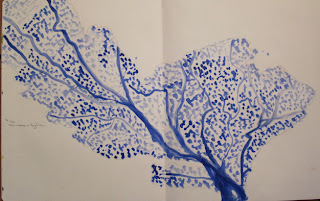I have been working on a painting project over this past year. I am calling it Vegetable Portraits. Vegetable Portraits consists of nineteen small paintings and four soon-to-be large-scale paintings. Essays accompany the smaller paintings of vegetables, farms and farmers, and reflect the moment of the painting, the nature of the subject or the thoughts that the subject inspired within me. I have just completed two large-scale (4’ x 3’) renditions of two of the smaller paintings, and plan to create several more as part of the series. These large paintings further explore the color, space and compositional relationships initiated in the smaller pieces.
Getting into the large-scale painting below of the Cukes, I began to see the relationships more clearly and how critical the transitions and so-called negative spaces are to the piece. Working big, it was easier to get lost in the painting - the movement, the color and defining the edges of the Cukes to create the spaces between. It's amazing that those spaces where "nothing" has been created become essential to the poetry of anything - paintings, landscape, dance. Some of the most eloquent thoughts on the importance of "betweeness" I've come across came from a New York Times book review on The View from Lazy Point, in which the author attempts to relay Carl Safina's views on the meaning of life. It makes me want to read the book.
...Safina asks us to reconsider the importance of that perennial question: “What is the meaning of life?” Which, he believes, is the wrong question to be asking because “it makes you look in the wrong places.” The right question is, “Where is the meaning in life.” And the place to look is “between.” In other words, we should look for the ways that all living creatures and all habitats are connected, look for what happens “between” them. “Relationships,” he insists, “are the music life makes. Context creates meaning.”
By DOMINIQUE BROWNING Published: January 14, 2011
Perhaps that is some of the answer to my question in my last blog about how to choreograph transitions and create that sublime between.
 |
| Cukes - 10"x14" |
 |
| Cukes - 3'x4' |

